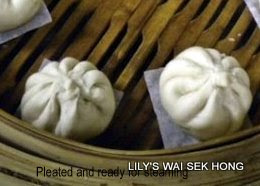I have been watching this Pau Pleating Video for umpteen times and still not able to pleat as pretty. The saying is true - Hard to teach old dogs new tricks. These pictures showed that i tried and perhaps i will have to make more than 360 paus to really pleat well.
Serves








21 comments:
I believe the adage does not hold true in acquiring the pleating pau skills. It is day-to-day hands on experience. I have seen a couple of YouTube pau pleating, I myself is amazed how these folks do it in a split of a second. These folks do it for a living and we don’t. We do it for passion so eventually we will get there. We are very close and yet so near the finish line. Your pleated paus look great! Homemade goodies are still the best to me.
Wow, I never knew it was made. I make a filipino version called siopao and it never comes out pretty. I have to try it next time.
ube
you are too kind
I think you've done a lovely job, Lily.
Wow you did a really good job. I bet if you do it all the time it would become so natural, like those who make pretzels:)
kong hei fatt choy to you too, lily! i don't think i can ever master pleating paus to what you are able to. seems difficult to me. haven't even tried making paus, much less pleating one :)
Aunty Lily, I can never pleat pau as nicely as yours!
Lily,
I love the rustic look... a sign that the pau is truly made at home ;-)
tuty
how true, i don't know why we expect factory made symetrical shapes to be nice and consider irregulars homemade as imperfection. so sad.
Yet we still strive for excellence! I know of somebody who has taken lots of 'credit hours' into the pleating of the bao and gets so thrilled in the process and that Lily is your passion :)!! I am so glad, as a result of that passion your blog has touched so many lives ~ inspired many amateur cooks, dared the more experienced ones and satisfied many a hungry stomach who is far from their homeland and long for a taste of home. I have been a blessed recipient of that passion. I join many to express my heartfelt thanks and appreciation for your generosity. We look forward to many years of good cooking and eating well with you!
Peng
we are still striving for excellence and i think that we have learn to accept imperfections as they are special and one of a kind.
Thank you for being a friend
Hello Lily
Gong Hii Fatt Choy to you!
Saw the photos of the pau, very impressive. Your kitchen looks very professional, like those restaurant's.
Is that a must to use those bamboo steamers for making pau? will those aluminium steamers give the same result? and for the bamboo steamer, we still put a pot of water at the very bottom, but what to put on top as the lid? the bamboo lid or the normal wok lid?
Yeou-Lee
yeou lee
happy new year to you and family too.
The kitchen is really a commercial kitchen. I was helping a dear friend to make paus and long yoke.
Bamboo steamer is not a must for steaming pau but preferable cos the bamboo lid/cover to the steamer does not hold condensation.
Thanks Lily. Then I have to consider buying some bamboo steamers and the lid. We do use normal wok or aluminium steamer base as the base to steam the pau, right?
Yeou-Lee
I've seen an easier way, cheating but get the same effect. First, Seal all corners of the dough together. To get the pleated effect use the edge of a spoon and press it into the dough all around. That way, you can do as many "pleats" and how deep you want then to be.
anonymous
thanks for this great tip
anonymous
thanks for this great tip
anonymous
thanks for this great tip
anonymous
thanks for this great tip
May I know whether I should leave the pleasted pau to rise again or put it straight to steam? If so do I have the water boiled first or as one of the bloggers who folllowed your pau recipe said she actually steam it from cold water?
cathryn
these paus have to rise again for about 1/2 hr or more before steaming. so, while it is rising, boil the watr in the steamer. logically, you can put to steam in cold water and as the water gets heated up, the paus will get the rise it requires and the high heat will kill the yeast finally. When putting the paus to steam in high heat, you can monitor the rising and as soon as the paus get the heat, the yeast will be killed and there will be no further rising.
Post a Comment